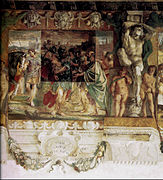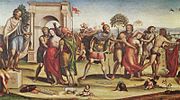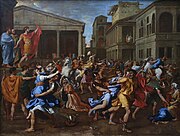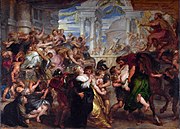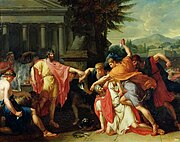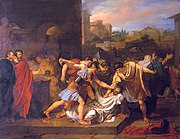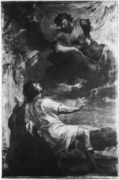Romulus
This articleneeds additional citations forverification.(September 2023) |
| Romulus | |
|---|---|
 Romulus and his twin brother Remus from a 15th-century frieze,Certosa di Pavia | |
| King of Rome | |
| Reign | 753–716 BC (traditional dates) |
| Successor | Numa Pompilius |
| Born | Alba Longa |
| Died | Rome |
| Spouse | Hersilia |
| Father | Mars |
| Mother | Rhea Silvia |
Romulus(/ˈrɒmjʊləs/,Classical Latin:[ˈroːmʊɫʊs]) was the legendaryfounderandfirst kingofRome.Various traditions attribute the establishment of many of Rome's oldest legal, political, religious, and social institutions to Romulus and his contemporaries. Although many of these traditions incorporate elements offolklore,and it is not clear to what extent a historical figure underlies the mythical Romulus, the events and institutions ascribed to him were central to the myths surrounding Rome's origins and cultural traditions.
Traditional account
[edit]The myths concerning Romulus involve several distinct episodes and figures, including the miraculous birth and youth of Romulus and histwin brother,Remus;Remus' murder and the founding of Rome;the Rape of the Sabine Women,and the subsequent war with theSabines;a period of joint rule withTitus Tatius;the establishment of various Roman institutions; the death orapotheosisof Romulus, and the succession ofNuma Pompilius.[citation needed]
Romulus and Remus
[edit]According toRoman mythology,Romulus and Remus were the sons ofRhea Silviaby the godMars.Their maternal grandfather wasNumitor,the rightful king ofAlba Longa,through whom the twins were descended from both theTrojanheroAeneas,andLatinus,the king ofLatium.[citation needed]Before the twins' birth, Numitor's throne had been usurped by his brother,Amulius,who murdered Numitor's son or sons, and condemned Rhea Silvia to perpetual virginity by consecrating her aVestal.[i][1][2]When Rhea became pregnant, she asserted that she had been visited by the god Mars. Amulius imprisoned her, and upon the twins' birth, ordered that they be thrown into theTiber.But as the river had been swollen by rain, the servants tasked with disposing of the infants could not reach its banks, and soexposedthe twins beneath a fig tree at the foot of thePalatine Hill.[1][3]
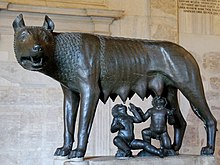
In the traditional account, ashe-wolfhappened upon the twins, and suckled them until they were found by the king's herdsman,Faustulus,and his wife,Acca Larentia.[ii]The brothers grew to manhood among the shepherds and hill-folk. After becoming involved in a conflict between the followers of Amulius and those of their grandfather Numitor, Faustulus told them of their origin. With the help of their friends, they lured Amulius into an ambush and killed him, restoring their grandfather to the throne.[5][6]The princes then set out to establish a city of their own.[citation needed]
They returned to thehills overlooking the Tiber,near where they had been exposed as infants, but disagreed on the site of their new city. Each took up station on a different hill, and awaited an omen to decide between them. Remus sighted six vultures over the Aventine Hill, then Romulus saw a flight of twelve above the Palatine Hill. Remus argued for the Aventine based on priority, Romulus the Palatine based on number. The conflict escalated, and Romulus or one of his followers killed Remus.[5][7]In a variant of the legend, the augurs favoured Romulus, who proceeded toplough a square furrowaround the Palatine Hill to demarcate the walls of the future city (Roma Quadrata). When Remus derisively leapt over the "walls" to show how inadequate they were against invaders, Romulus struck him down in anger. In another variant, Remus was killed during a melée, along with Faustulus.[citation needed]
Establishment of the city
[edit]The founding of Rome was commemorated annually on April 21, with the festival of theParilia.[iii][iv]Romulus' first act was to fortify the Palatine with theMurus Romuli,in the course of which he made a sacrifice to the gods. He laid out the city's boundaries with a furrow that he ploughed, performed another sacrifice, and with his followers set to work building the city itself.[8][9]Romulus sought the assent of the people to become their king. With Numitor's help, he addressed them and received their approval. Romulus accepted the crown after he sacrificed and prayed toJupiter,and after receiving favourable omens.[10]
Romulus divided the populace into threetribes,known as theRamnes,Titienses,andLuceres,[v]for taxation and military purposes. Each tribe was presided over by an official known as atribune,and was further divided into tencuria,or wards, each presided over by an official known as acurio.Romulus also allotted a portion of land to each ward, for the benefit of the people.[11][12]Nothing is known of the manner in which the tribes and curiae were taxed, but for the military levy, each curia was responsible for providing one hundred foot soldiers, a unit known as acentury,[vi]and ten cavalry. Each Romulean tribe thus provided about one thousand infantry, and one century of cavalry; the three hundred cavalry became known as theCeleres,"the swift", and formed the royal bodyguard.[13][14]
Choosing one hundred men from the leading families, Romulus established theRoman senate.These men he calledpatres,the city fathers; their descendants came to be known as "patricians",forming one of the two major social classes at Rome. The other class, known as the"plebs"or" plebeians ", consisted of the servants, freedmen, fugitives who sought asylum at Rome, those captured in war, and others who were granted Roman citizenship over time.[15][16]
To encourage the growth of the city, Romulus outlawed infanticide, and established anasylumfor fugitives on theCapitoline Hill.Here freemen and slaves alike could claim protection and seek Roman citizenship.[17][18]
The Rape of the Sabine Women
[edit]The new city was filled with colonists, most of whom were young, unmarried men. While fugitives seeking asylum helped the population grow, single men greatly outnumbered women. With no intermarriage taking place between Rome and neighboring communities, the new city would eventually fail. Romulus sent envoys to neighboring towns, appealing to them to allow intermarriage with Roman citizens, but his overtures were rebuffed. Romulus formulated a plan to acquire women from other settlements. He announced a momentousfestival and games,and invited the people of the neighboring cities to attend. Many did, in particular theSabines,who came in droves. At a prearranged signal, the Romansseized and carried offthe marriageable women among their guests.[15]
The aggrieved cities prepared for war with Rome, and might have defeated Romulus had they been fully united. But impatient with the preparations of the Sabines, the Latin towns ofCaenina,Crustumerium,andAntemnaetook action without their allies. Caenina was the first to attack; its army was swiftly put to flight, and the town taken. After personally defeating and slaying the prince of Caenina in single combat, Romulus stripped him of his armour, becoming the first to claim thespolia opima,and vowed to build atemple to Jupiter Feretrius.Antemnae and Crustumerium were conquered in turn. Some of their people, chiefly the families of the abducted women, were allowed to settle in Rome.[19]
Following the defeat of the Latin towns, the Sabines, under the leadership ofTitus Tatius,marshalled their forces and advanced upon Rome. They gained control of the citadel by bribingTarpeia,the daughter of the Roman commander charged with its defense. Without the advantage of the citadel, the Romans were obliged to meet the Sabines on the battlefield. The Sabines advanced from the citadel, and fierce fighting ensued. The nearbyLacus Curtiusis said to be named after Mettius Curtius, a Sabine warrior who plunged his horse into its muck to stymie his Roman pursuers as he retreated. At a critical juncture in the fighting, the Romans began to waver in the face of the Sabine advance. Romulus vowed to build atemple to Jupiter Stator,[vii]to keep his line from breaking. The bloodshed finally ended when the Sabine women interposed themselves between the two armies, pleading on the one hand with their fathers and brothers, and on the other with their husbands, to set aside their arms and come to terms. The leaders of each side met and made peace. They formed one community, to be jointly ruled by Romulus and Tatius.[20]
Subsequent events
[edit]The two kings presided over the growing city of Rome for a number of years, before Tatius was slain in a riot atLavinium,where he had gone to make a sacrifice. Shortly before, a group of envoys fromLaurentumhad complained of their treatment by Tatius' kinsmen, and he had decided the matter against the ambassadors. Romulus resisted calls to avenge the Sabine king's death, instead reaffirming the Roman alliance with Lavinium, and perhaps preventing his city from splintering along ethnic lines.[21]
In the years following the death of Tatius, Romulus is said to have conquered the city ofFidenae,which, alarmed by the rising power of Rome, had begun raiding Roman territory. The Romans lured the Fidenates into an ambush, and routed their army; as they retreated into their city, the Romans followed before the gates could be shut, and captured the town. TheEtruscancity ofVeii,nine miles up the Tiber from Rome, also raided Roman territory, foreshadowing that city's role as the chief rival to Roman power over the next three centuries. Romulus defeated Veii's army, but found the city too well defended to besiege, and instead ravaged the countryside.[22]
Death and succession
[edit]After a reign of thirty-seven years,[23][24]Romulus is said to have disappeared in awhirlwindduring a sudden and violent storm, as he was reviewing his troops on theCampus Martius.Livy says that Romulus was either murdered by the senators, torn apart out of jealousy, or was raised to heaven by Mars, god of war. Livy believes the last theory regarding the legendary king's death, as it allows the Romans to believe that the gods are on their side, a reason for them to continue expansion under Romulus' name.[25]
Romulus acquired a cult following, which later became assimilated with the cult ofQuirinus,perhaps originally the indigenous god of the Sabine population. As the Sabines had not had a king of their own since the death of Titus Tatius, the next king of Rome,Numa Pompilius,was chosen from among the Sabines.[26]
Various sources state that Romulus had a wife,Hersilia.In Livy, following the defeat of the Caeninenses and the Antemnates, the Sabine women begged Hersilia to intercede with her husband on behalf of their families so that they would be received into the state rather than slain by Roman arms.[27]In Dionysius, Hersilia was herself one of the Sabine women, and the only one who was already married at the time of her abduction. Dionysius explains that she was either mistaken for a virgin, or, he thinks more probably, that she was the mother of one of those abducted, and refused to abandon her daughter.[28]Plutarch also relates that Hersilia was one of the Sabine women, and the only one already married. He also mentions that some authorities make Hersilia the wife ofHostus Hostilius,rather than Romulus. Two children are attributed to Romulus in Plutarch: a daughter, Prima, and a son, Avillius, but here Plutarch notes that his source, Zenodotus of Troezen, is widely disputed.[29]
Primary sources
[edit]Livy,Dionysius,andPlutarchrely onQuintus Fabius Pictoras a source. Other significant sources includeOvid'sFasti,andVirgil'sAeneid.Greek historians had traditionally claimed that Rome was founded by Greeks, a claim dating back to thelogographerHellanicus of Lesbosof 5th-century BC, who named Aeneas as its founder. Roman historians connect Romulus to Aeneas by ancestry and mention a previous settlement on thePalatine Hill,sometimes attributing it toEvanderand his Greek colonists. To the Romans, Rome was the institutions and traditions they credit to their legendary founder, the first "Roman".[30]
The legend as a whole encapsulates Rome's ideas of itself, its origins and moral values. For modern scholarship, it remains one of the most complex and problematic of all foundation myths. Ancient historians had no doubt that Romulus gave his name to the city. Most modern historians believe his name is aback-formationfrom the name of the city. Roman historians dated the city's foundation to between 758 and 728 BC, andPlutarchreports the calculation ofVarro's friendTarutiusthat 771 BC was the birth year of Romulus and his twin.[31]The tradition that gave Romulus a distant ancestor in the semi-divineTrojanprinceAeneaswas further embellished, and Romulus was made the direct ancestor ofRome's first Imperial dynasty.It is unclear whether or not the tale of Romulus or that of the twins are original elements of the foundation myth, or whether both or either were added.
Romulus-Quirinus
[edit]
Ennius(fl. 180s BC) refers to Romulus as a divinity in his own right, without reference toQuirinus.Roman mythographers identified the latter as an originallySabinewar-deity, and thus to be identified with RomanMars.Luciliuslists Quirinus and Romulus as separate deities, andVarroaccords them different temples. Images of Quirinus showed him as a bearded warrior wielding a spear as a god of war, the embodiment of Roman strength and a deified likeness of the city of Rome. He had aFlamen Maiorcalled theFlamen Quirinalis,who oversaw his worship and rituals in the ordainment of Roman religion attributed to Romulus's royal successor,Numa Pompilius.There is however no evidence for the conflated Romulus-Quirinus before the 1st century BC.[32][33]
OvidinMetamorphosesXIV (lines 805-828) gives a description of thedeificationof Romulus and his wifeHersilia,who are given the new names of Quirinus and Hora respectively. Mars, the father of Romulus, is given permission byJupiterto bring his son up to Olympus to live with theOlympians.[34]
One theory regarding this tradition proposes the emergence of two mythical figures from an earlier, singular hero. While Romulus is a founding hero, Quirinus may have been a god of the harvest, and theFornacaliaa festival celebrating a staple crop (spelt). Through the traditional dates from the tales and the festivals, they are each associated with one another. A legend of the murder of such a founding hero, the burying of the hero's body in the fields (found in some accounts), and a festival associated with that hero, a god of the harvest, and a food staple is a pattern recognized byanthropologists.Called a "demaarchetype ", this pattern suggests that in a prior tradition, the god and the hero were in fact the same figure and later evolved into two.[35]
Historicity
[edit]Possible historical bases for the broad mythological narrative remain unclear and disputed.[viii]
Modern scholarship approaches the various known stories of the myth as cumulative elaborations and later interpretations of Romanfoundation myth.Particular versions and collations were presented by Roman historians as authoritative, an official history trimmed of contradictions and untidy variants to justify contemporary developments, genealogies and actions in relation toRoman morality.Other narratives appear to represent popular or folkloric tradition; some of these remain inscrutable in purpose and meaning.T.P. Wisemansums up the whole issue as themythographyof an unusually problematic foundation and early history.[36][37]
The unsavoury elements of many of the myths concerning Romulus have led some scholars to describe them as "shameful" or "disreputable".[38]: 60–2 In antiquity such stories became part of anti-Roman and anti-pagan propaganda. More recently, the historianHermann Strasburgerpostulated that these were never part of authentic Roman tradition, but were invented and popularized by Rome's enemies, probably inMagna Graecia,during the latter part of the fourth century BC.[38]: 60–2 This hypothesis is rejected by other scholars, such asTim Cornell(1995),[38]who notes that by this period, the story of Romulus and Remus had already assumed its standard form, and was widely accepted at Rome. Other elements of the Romulus mythos clearly resemble common elements of folk tale and legend, and thus strong evidence that the stories were both old and indigenous.[38]: 60–2 Likewise, Momigliano finds Strasburger's argument well-developed, but entirely implausible; if the Romulus myths were an exercise in mockery, they were a signal failure.[37]
Depictions in art
[edit]The episodes which make up the legend, most significantly that ofthe rape of the Sabine women,the tale ofTarpeia,and the death of Tatius have been a significant part ofancient Roman scholarshipand the frequent subject of art, literature and philosophy since ancient times.
Palazzo Magnani
[edit]In the late 16th century, the wealthyMagnanifamily from Bologna commissioned a series of artworks based on the Roman foundation myth. The artists contributing works included a sculpture of Hercules with the infant twins by Gabriele Fiorini, featuring the patron's own face. The most important works were an elaborate series of frescoes collectively known asHistories of the Foundation of Romeby the Brothers Carracci:Ludovico,Annibale,andAgostino.
-
Romulus marking the city's boundaries with a plough
-
The Asylum (Inter duos Lucos)
-
The rape of the Sabine women
-
Romulus dedicating the temple to Jupiter Feretrius
-
The Battle of the Lacus Curtius
-
The death of Titus Tatius in Laurentium
-
Romulus appearing to Proculus Julius
-
The Pride of Romulus
The rape of the Sabine women in paintings and sculpture
[edit]-
Il Sodoma(1507)
-
Nicolas Poussin(1638)
-
Peter Paul Rubens(1634–36)
-
Giambologna(1583)
-
Jacopo Ligozzi(c.1565-1627)
-
Attributed toTheodoor van Thulden(17th c.)
-
Sebastiano Ricci(c. 1700)
-
Charles Christian Nahl(1870)
Tarpeia
[edit]-
The Vestal Virgin Tarpeia Beaten by Tatius’ soldiersIl Sodoma(16th c.)
-
Tarpeia's punishment, Pentelic marble fragment from the Frieze of theBasilica Aemilia(100 BC-100 AD
-
Reconstruction of Basilica Aemilia Frieze marble fragment
-
Tarpeia, Illustration fromPictura loquens"the Heroic Accounts of Hadrian Schoonebeeck"(1695) (14751427905)
-
Tarpeia conspires with Tatius in an illustration fromThe story of the RomansbyHélène Adeline Guerber(1896)
Hersilia
[edit]-
Print from Romolo ed Ersilia, final scene, Act 3, Artist;:Giovanni Battista Cipriani,Engraver:Francesco Bartolozzi(1781)
-
Hersilia from a detail ofLes Sabines"The Intervention of the Sabine Women",Jacques-Louis David(1799)
Death of Tatius
[edit]The subject for the 1788Prix de Romewas the death of Tatius (La mort de Tatius). Garnier won the contest.
-
Version byÉtienne-Barthélémy Garnier,now in theÉcole nationale supérieure des beaux-arts,Paris.
-
Version byGirodet,now in theMusée des Beaux-Arts d'Angers.
Death of Romulus
[edit]-
"Apparition of Romulus before Proculus",Rubens(17th c.)
See also
[edit]Notes
[edit]- ^Dionysius describes an ambush of Numitor's son, who was hunting; Livy indicates that there were multiple sons, but does not give any details of their murder. Dionysius also gives an alternate name,Ilia,for Rhea Silvia.
- ^In another version, the she-wolf of the legend was Acca Larentia herself, who was a prostitute nicknamed "Lupa" by the shepherds.[4]
- ^Dionysius suggests that the Parilia may have predated the founding of the city, and been chosen by Romulus because it was an auspicious occasion.
- ^The founding of Rome fell on the Parilia, according to the oldest survivingRoman calendar(Rodriguez Mayorga 2010, p. 97).
- ^These names probably do not date from the time of Romulus; modern scholars have inferred that they were originally ethnic tribes representing different elements of the early Roman population, with theRamnesrepresenting the Latins, theTitiensesthe Sabines, and theLuceresthe Etruscans. TheLuceresmay have been a later addition to the original Romulean tribes, but as the Tiber formed the traditional boundary between Latium and Etruria, it is not unlikely that there were Etruscan settlers from the earliest period.
- ^As the name suggests, a unit of one hundred men, although in later times a century was usually smaller, comprising about sixty men.
- ^Jupiter the Steadfast.
- ^The archaeologistAndrea Carandiniis one of very few modern scholars who accept Romulus and Remus as historical figures, based on the 1988 discovery of an ancient wall on the north slope of the Palatine Hill in Rome. Carandini dates the structure to the mid-8th century BC and names it theMurus Romuli.
See: Carandini (1997),La nascita di Roma. Dèi, lari, eroi e uomini all'alba di una civiltà(Torino: Einaudi); Carandini (2006),Remo e Romolo. Dai rioni dei Quiriti alla città dei Romani (775/750 - 700/675 a. C. circa)(Torino: Einaudi); and Carandini (2011).Rome: Day One.Princeton, NJ: Princeton University Press.ISBN978-0-691-13922-7.
Citations
[edit]- ^abLivy,History of Romei. 3.
- ^Dionysius of Halicarnassus,Roman Antiquitiesi. 76.
- ^Dionysius, i. 77–79.
- ^Livy, i. 4.
- ^abLivy, i. 3–6.
- ^Dionysius, i. 79–83.
- ^Dionysius, i. 85–87.
- ^Livy, i. 7.
- ^Dionysius, i. 88.
- ^Dionysius, ii. 3–6.
- ^Dionysius, ii. 7.
- ^Varro Reatinus,On the Latin Languagev. 81, 89.
- ^Livy, i. 13, 15.
- ^Dionysius, ii. 13.
- ^abLivy, i. 9.
- ^Dionysius, ii. 8, 12, 13.
- ^Livy, i. 8.
- ^Dionysius, ii. 15.
- ^Livy, i. 10.
- ^Livy, i. 11–13.
- ^Livy, i. 13.
- ^Livy, i. 14–15.
- ^Livy,I."Romulus reigned thirty-seven years."
- ^Plutarch,Parallel Lives,Romulus."Romulus is said to have been fifty-four years of age, and in the thirty-eighth year of his reign when he disappeared from among men."
- ^Livy, i. 16.
- ^Livy, i. 17, 18.
- ^Livy, i. 11.
- ^Dionysius, ii. 45.
- ^Plutarch, "The Life of Romulus", 14, 18, 19.
- ^Rodriguez Mayorgas (2010), pp. 92–94
- ^Plutarch.Life of Romulus.12.5.
- ^Evans, 103 and footnote 66: citing quotation ofEnnius in Cicero,1.41.64.
- ^Fishwick, Duncan (1993),The Imperial Cult in the Latin West(2nd ed.), Leiden: Brill, p. 53,ISBN978-90-04-07179-7.
- ^Cook, John Granger (2018).Empty Tomb, Resurrection, Apotheosis.p. 263.doi:10.1628/978-3-16-156584-7.ISBN9783161565847.
- ^Brelich, Angelo. 1960.Quirinus: una divinita' romana alla luce della comparazione storica"Studi e Materiali di Storia delle religioni".
- ^Wiseman, T. P. (1995),Remus, A Roman Myth,Cambridge: Cambridge University Press.
- ^abMomigliano, Arnoldo (2007), "An interim report on the origins of Rome",Terzo contributo alla storia degli studi classici e del mondo antico,vol. 1, Rome, IT: Edizioni di storia e letteratura, pp. 545–98,ISBN9788884983633.— A critical, chronological review of historiography related to Rome's origins.
- ^abcdCornell, Tim (1995),The Beginnings of Rome: Italy and Rome from the Bronze Age to the Punic Wars (c. 1000–264 BC).London: Routledge,ISBN978-1-136-75495-1.
Bibliography
[edit]- Cornell, T. (1995),The Beginnings of Rome: Italy and Rome from the Bronze Age to the Punic Wars (c. 1000–264 BC),Routledge,ISBN978-1-136-75495-1
- Rodríguez Mayorgas, Ana (2010),"Romulus, Aeneas and the Cultural Memory of the Roman Republic"(PDF),Athenaeum,98(1): 89–109,retrieved14 December2016
- Tennant, P. M. W. (1988)."The Lupercalia and the Romulus and Remus Legend"(PDF).Acta Classica.XXXI:81–93.ISSN0065-1141.Archived fromthe original(PDF)on 10 May 2017.Retrieved19 November2016.
- Wiseman, T. P. (1983). "The Wife and Children of Romulus".The Classical Quarterly.XXXI(ii). Cambridge University Press: 445–452.doi:10.1017/S0009838800034704.JSTOR638787.S2CID170700760.
- Cook, John Granger (2018),Empty Tomb, Apotheosis, Resurrection,p. 263.
- Hyden, Marc (2020),Romulus: The Legend of Rome's Founding Father,Pen and Sword History, ISBN 9781526783172.
Ancient Sources
[edit]- Dionysius of Halicarnassus,Roman Antiquitiesi & ii.
- Livy,History of Romei–v.
Further reading
[edit]- Carandini, Andrea (2011).Rome: Day One.Princeton, N.J: Princeton University Press.ISBN978-0-691-13922-7.
- Forsythe, Gary (2005).A Critical History of Early Rome: From Prehistory to the First Punic War.Berkeley: University of California Press.ISBN978-0-520-22651-7.
- 8th-century BC Romans
- 8th-century BC monarchs
- Kings of Rome
- Deified ancient Roman men
- Deified male monarchs
- Deified Roman monarchs
- Founding monarchs
- Missing person cases in Italy
- People from Alba Longa
- People whose existence is disputed
- Romulus and Remus
- Mythological fratricides
- Mythological city founders
- Mythological Italian people




